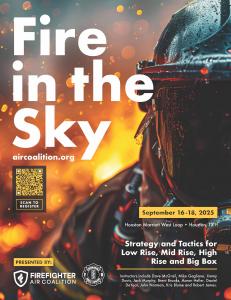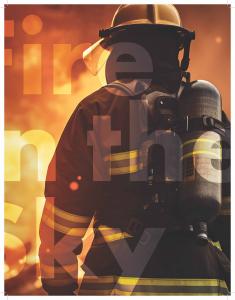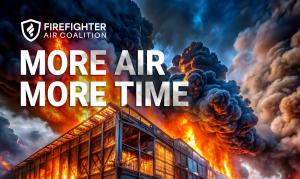High-Rise and Big-Box Fire Serivce Experts Embark Upon Texas for Intensive Structural Fireground Training Session
Critical insights on high-rise firefighting, standpipe operations, super-block complexes, commercial tactics, big box with limited staffing, and air safety.
In the United States, big-box distribution centers are swallowing the rural landscapes. Small towns close to interstate transportation are targets for large-scale distribution centers. The challenge is those small towns have small fire departments. What happens when 1,000,000 square foot facility moves into that small town with a combination fire department of 10 people, a ladder truck, a couple of pumpers and maybe an ambulance to provide fireground operations for 1,000,000 square feet?
Developers and construction contractors don't seem too concerned about it because there are sprinkler mandates and sprinklers will "put out" the fire. BUT that is not the case. Sprinklers, while life and property saving, are meant to contain the fire until firefighters can arrive to engage the fire attack, which is search and rescue, extinguishment, overhaul, and salvage. Smaller fire departments throughout the country are being faced with this dilemma.
Experts including, Kris Blume, John Norman, Daniel DeYear, Aaron Heller, Jack Murphy, Dave McGrail, Brent Brooks, Jimmy Davis, Mike Gagliano and Robert James (RJ) will bring their expertise to the classroom to delve into the topics of big box fires with limited staffing, high-rise and standpipe operations, super-block complexes, high-rise and big-box firefighting, commercial tactics, firefighter air, and essential lessons learned from extreme fire events.
The Houston Fire Department has embraced this essential three-day event to equip firefighters with the knowledge, skills and tools they need to navigate the new challenges of high-rise, mid-rise and big-box fires.
Navigating Vertical and Horizontal Growth
Modern cityscapes present unique challenges to emergency responders. High-rises and sprawling complexes are emblematic of the urban and rural sprawl, introducing unprecedented complexity in firefighting operations. Firefighter limited air supply, unique to large-scale structures, demands new tactical approaches to meet the oath of safeguarding life and property. Fire in the Sky is not just an event—it's a necessary evolution in how we approach firefighting in these environments.
Firefighter air supply is challenged by the sheer size and magnitude of these buildings. Navigating these structures, particularly when lives are at risk, can be stressful and challenging when a 45-minute cylinder of compressed air may give a firefighter 13-15 minutes of breathable air for the fire attack.
It takes three things to fight a fire: firefighters, water and air. Without air – there is no interior attack.
Stairway to Hell
High-rise structures have been likened to large distribution warehouses standing on end. Both pose similar dangers, but notable differences exist due to height. “The elevators are out - we’ll have to take the stairs” has probably been heard by every firefighter who’s battled high-rise fires. Industry studies tell us that "a firefighter can climb one minute per floor wearing Personal Protective Equipment. However, fatigue becomes a critical factor by about the 12th floor," says Jimmy Davis, a high-rise fire service instructor and a Captain with the Chicago Fire Department.
Capt. Davis shared that in a 27th-floor climb scenario, even if a few firefighters make it to the 27th floor, how effective will they be in initiating an effective, collaborative fire attack? Most likely the firefighting contingent will be a splintered group from different fire units lacking adequate supervision, affecting their ability to coordinate an effective fire attack. This is a realistic example of systemic failure, potentially affecting every portion of the high-rise operation.
Firefighter Air Supply Challenged
The major challenge with fighting fires in big-box and high-rise building structures is firefighter air. The challenge of getting water supply was greatly reduced by the implementation of water standpipes as far back as 1840. Air, however, seems to have eluded our understanding as the one commodity that firefighters need to do their job.
“High-rise fires require many full air cylinders,” says Capt. Davis. “Fresh air cylinders must be available without delay during a high-rise fire. In the early stages of fire suppression, air cylinders are supplied in limited quantities. After about twenty minutes, supplemental air cylinders need to brought in. If they are delayed, say, by a lengthy stairwell-only ascend, the entire high-rise operation is set back. This is due to the inability and lack of support to replenish breathing air for already committed firefighters.”
The supreme challenge in these sprawling vertical and horizonal structures is the air supply for freighters. With a limited air supply, the fire attack is at risk. Without air, they may have to retreat from the attack and switch to an exterior strategy, which delays rescue efforts and exposes citizens to significant threats.
Millions of Horizontal Square Feet
Big-box stores, distribution centers and warehouses present numerous fire hazards due to their size, inventory diversity, and storage practices. These facilities can contain flammable liquids, electronics with lithium-ion batteries, and large quantities of goods made of plastic materials and textiles, which can rapidly ignite.
High ceilings and vast open spaces offer a make-ready volume of air that can rapidly fuel a fire. While buildings of this size generally require sprinkler systems in buildings, it’s important to understand this is the same challenge experienced in high-rise, but it's a horizontal. The fire is only contained by the sprinklers. Firefighters are still required to conduct search and rescue, carry out overhaul operations in a cloud of gases, toxicants and carcinogens. These activities all require a continuous, breathable air supply. Firefighters simply CANNOT breathe the toxic, asphyxiating smoke and gases on today's fireground.
Research conducted by Underwriters Laboratories, Inc. found that the “smoke and gas levels were quickly reduced by suppression activity however they remained an order of greater magnitude during overhaul.” IDLH (Immediate Danger to Life and Health) levels of carbon monoxide and hydrogen cyanide (The Toxic Twins), benzene, formaldehyde and arsenic were exceeded during fire growth and overhaul stages, all of which firefighters would be exposed to without air. What this means is that firefighters absolutely must have a continuous breathable air supply to protect them from the fire smoke and toxic gases. Otherwise, they are at risk of cumulative or immediate, life and health consequences.
Introducing New Air Technology
Advanced technology plays a pivotal role in modern firefighting, enhancing safety and efficiency on the fireground. Innovations and best practices in firefighter air safety can be the difference between life and death. Simply stated firefighters need More Air, More Time. Understanding that fact is key to embracing the idea that firefighters must rely on new air technologies to extend their human respiratory capabilities.
As Steve Sanguedolce, President of Affordable Drill Towers, explains, construction of buildings is ever-changing, and the challenges that firefighters face are no exception. It is our absolute commitment to provide firefighters with the highest quality training from some of the most skilled, experienced, knowledgeable, and seasoned instructors."
"This is a new era for firefighting" said Mike Gagliano, President of the FAC. We don't live in a world of wood and paper anymore. Our homes and buildings are made with synthetic building materials. We have plastics and polymers in nearly everything in our home. When those things burn, we have to navigate a toxic, asphyxiating, suffocating environment to save life and property. Big buildings take more air. Technology is advancing and firefighters need to understand it's necessity."
Meet the Masters of High-Rise, Mid-Rise and Big Box Firefighting
Fire In the Sky brings together a stellar lineup of instructors, each a luminary in the field of firefighting with a wealth of experience and expertise:
- Brent Brooks, a renowned figure in high-rise operations from Toronto Fire Services, will lead "Highrise Firefighting," focusing on updated equipment and tactics necessary for modern skyscrapers.
- Dave McGrail of Denver Fire Department (retired) will present "High Rise Ops: Keep it Simple," emphasizing straightforward strategies for effective incident management in complex structures.
- Jimmy Davis, with over 30 years at the Chicago Fire Department, will conduct "Protecting Vertical Cities: The First Five Minutes," centered on critical, time-sensitive decision-making during high-rise fires.
- John Norman, a veteran of FDNY, will share his expertise in "Lessons Learned from Extreme Fire Events," with insights into strategies developed from past firefighter fatalities.
- Mike Gagliano, from Seattle Fire Department (retired), will delve into air management tactics in "Lost, Disoriented & Out of Air," crucial for ensuring firefighter air safety in large-scale incidents.
- Jack Murphy, an expert in high-rise buildings and fire response, will address "Response Challenges: Super Block Hospital," covering strategic responses to complex urban structures.
- Daniel DeYear, retired Deputy Chief of Operations from the Dallas Fire Department will explore "Low and Mid-Rise Building Construction, a Recipe for Disaster."
- Aaron Helller from Hamilton, New Jersey Fire Department will speak to Commanding the Commercial Fireground.
- Chief Kris Blume from Meridian Fire Department will present "When Size Matters: Navigating the Challenges of the Big Box," focusing on unique fire dynamics in expansive commercial spaces.
- Robert (RJ) James with the Frederick County Maryland Fire Department will present "Bigger Buildings Present Bigger Challenges."
These instructors are more than educators; they are guardians of their craft, imparting essential skills and knowledge to firefighters. "We all have to Up Our Game to live up to our oath to protect and preserve life and property," said Gagliano.
This conference will provide the foundation for more effective strategies, tactics and operations in the rapidly changing fireground environment of the mega buildings.
A Call to Action
"Buildings are taller and larger than ever before, increasing the scope and obstacles in the firefighter response to protect their citizens and preserve the property in our communities," said FAC President, Mike Gagliano. "Understanding firefighter air is limited, tactics and methods required to solve these emerging fireground challenges must include managing air. Without air – nothing can be done.”
Fire In the Sky is more than a conference—it's a call to action for firefighters to adapt to the complexities of modern urban and rural changing landscapes. In a world where cities continue to grow and evolve, the need for innovative firefighting approaches has never been more critical.
Register today at Fire in the Sky Registration and be part of shaping the future of firefighting. Attendees can select a two-day session or the full conference at registration.
The time for change is now. Equip yourself with the latest knowledge and skills at Fire in the Sky, and rise to meet the challenges of a new fireground, requiring a challenging firefight.
View Full Program
Shawn Longerich
Firefighter Air Coalition
+1 317-690-2542
email us here
Visit us on social media:
LinkedIn
Instagram
Facebook
Legal Disclaimer:
EIN Presswire provides this news content "as is" without warranty of any kind. We do not accept any responsibility or liability for the accuracy, content, images, videos, licenses, completeness, legality, or reliability of the information contained in this article. If you have any complaints or copyright issues related to this article, kindly contact the author above.
Search.co Launches Next-Generation AI Platform for Data Extraction, Ingestion, and Intelligent Action
Kenneth W. Welch Jr. Launches Platform to Liberate Artists From Algorithm Bias
Coworks CEO says employers should consider coworking spaces
Więcej ważnych informacji
 Jedynka Newserii
Jedynka Newserii

 Jedynka Newserii
Jedynka Newserii

Polityka

Polska może się stać Doliną Krzemową Europy. Potrzeba jednak wsparcia finansowego start-upów i mocniejszej deregulacji
Polskie start-upy skoncentrowane są głównie na rozwoju nowoczesnych technologii informatycznych i cyfrowych. Wyraźny nacisk na oprogramowanie i aplikacje oraz big data i data science wskazuje na silne zainteresowanie narzędziami analitycznymi i rozwiązaniami wspierającymi transformację cyfrową w różnych branżach – wynika z raportu „Rynek start-upów w Polsce. Trendy technologiczne”, który został opracowany w 2024 roku w MRiT. Zdaniem europarlamentarzystów Polska ma szansę się stać Doliną Krzemową, jednak rozwój start-upów blokowany jest m.in. przez ograniczony dostęp do finansowania oraz niekorzystne i nadmierne regulacje.
Transport
Na półmetku wakacji ceny paliw na stacjach nie powinny się wyraźnie zmienić. Znaczące różnice między regionami i stacjami

W sierpniu ceny benzyny, oleju napędowego i autogazu powinny pozostać na poziomach z lipca – uważa ekspertka rynku z firmy Reflex. Wyższe będą zawsze na stacjach premium, tych, które oferują bogatszą ofertę dodatkową, promocje dla uczestników programu lojalnościowego, oraz w regionach, w których tradycyjnie paliwa są droższe ze względu np. na wyższą siłę nabywczą mieszkańców. Różnice mogą sięgać kilkudziesięciu groszy na litrze. Obszary, wokół których te wartości oscylują, zależą z kolei od sytuacji globalnej. Warto patrzeć na sytuację na Bliskim Wschodzie i w Ukrainie.
Polityka
A. Mularczyk (PiS): Nawiązanie poważnego dialogu z Niemcami jest konieczne nie tylko w kontekście reparacji. Powinien być podpisany traktat polsko-niemiecki

– Nie wystarczy jednorazowy gest czy inicjatywa. To musi być podjęcie dialogu, być może też przygotowanie nowej umowy bilateralnej, nowego traktatu polsko-niemieckiego, który regulowałby wszystkie obszary, które wynikały ze skutków II wojny światowej – mówi Arkadiusz Mularczyk, poseł do Parlamentu Europejskiego z PiS-u. Podkreśla, że proces ten nie będzie łatwy, bo wymaga konsekwencji i stanowczości, ale widzi szansę w prezydenturze Karola Nawrockiego, który już zadeklarował kontynuację starań w tym zakresie. Zdaniem europosła wsparciem w polsko-niemieckim dialogu może być administracja Donalda Trumpa.
Partner serwisu
Szkolenia

Akademia Newserii
Akademia Newserii to projekt, w ramach którego najlepsi polscy dziennikarze biznesowi, giełdowi oraz lifestylowi, a także szkoleniowcy z wieloletnim doświadczeniem dzielą się swoją wiedzą nt. pracy z mediami.








![Nestlé w Polsce podsumowuje wpływ na krajową gospodarkę. Firma wygenerowała 0,6 proc. polskiego PKB [DEPESZA]](https://www.newseria.pl/files/1097841585/fabryka-nesquik_1,w_85,r_png,_small.png)




.gif)

 |
| |
| |
|